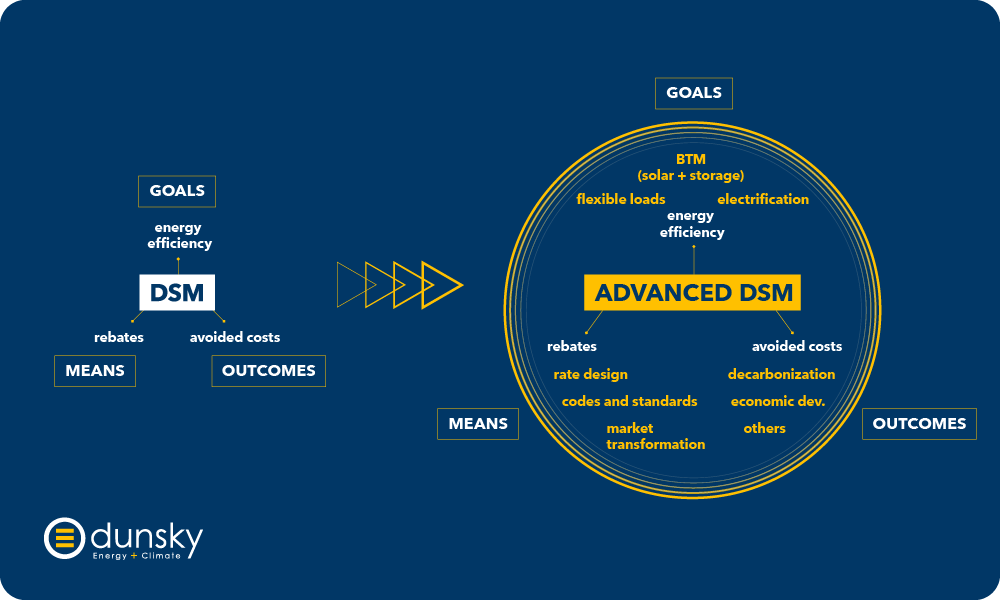Advanced DSM: Moving from Idea to Implementation

by Sam Ross & Raegan Bond
As utilities grapple with the twin challenges of decarbonizing existing supplies while rapidly building out new ones, DSM is being reshaped as a powerful new tool – Advanced DSMTM: one that can not only reduce demand, but also shape it and even grow it in ways that are beneficial to meeting both economic and environmental goals.
In an earlier article, Dunsky introduced the concept of Advanced DSMTM (see text box for recap), discussed its benefits, and identified high level barriers to unlocking its full potential. In this article, we dive deeper into these barriers across three categories – planning and regulatory frameworks, program design and delivery, and policy collaboration – and suggest actionable solutions that, if implemented thoughtfully, can accelerate this paradigm shift in support of decarbonization, enhanced grid resilience, and sustainable economic development.
Recap: What is Advanced DSMTM?
Advanced DSMTM – which focuses almost exclusively on reducing demand – is not revolutionary as much as evolutionary: the addition of load SHAPing began in earnest less than a decade ago, and the addition of load BUILDing in just the past couple of years.
Grounded by our work with utilities, governments and regulators across the US and Canada, Dunsky views Advanced DSMTM as expanding traditional DSM’s goals (beyond just efficiency), its means (beyond just rebates or other incentives), and its outcomes (beyond avoided costs of new supply). While traditional DSM was considered a static load modifier, Advanced DSM is a dynamic, flexible and scalable resource.

Update Regulatory Frameworks to Accelerate Advanced DSMTM
The regulatory frameworks that govern DSM were originally designed in an era when the primary goal was energy efficiency, measured in terms of avoided consumption and cost savings. As a result, many of today’s regulations do not accommodate the broader objectives and capabilities of Advanced DSMTM, such as load flexibility, behind-the-meter distributed energy resources (DERs), and electrification. Current frameworks often restrict DSM programs to load-reducing energy efficiency measures, sometimes paired with peak demand reduction contributions during a pre-defined peak period.
While integrated potential studies, Value of Solar studies and the National Standard Practice Manual (NSPM) are laying the groundwork for modelling and evaluating this broader version of DSM, other critical elements of DSM regulatory frameworks – including target setting, measure/program eligibility, attribution rules and performance incentive mechanisms – will need adjustments for utilities to be able and motivated to harness that potential.
When DSM is defined narrowly, it becomes difficult for utilities to integrate more dynamic approaches that support cost savings, grid resilience and decarbonization. For example, many DSM regulations have not evolved quickly enough to reflect the changing role of electricity in the energy transition, where load-building technologies like heat pumps are a critical piece of the puzzle.
Other strategies, like integrating rate design efforts alongside DSM programs would allow development of demand response incentive structures that correctly account for higher time-varying rates during peak periods, ensuring customers have strong incentives to participate while also reducing incentive costs, thereby maximizing the savings that flow to ratepayers. Similarly, while some programs have allowed utilities to claim savings from code enforcement or supporting efforts to go above existing code (e.g., in new construction), coordination with building performance standards represents a promising opportunity to both ‘raise the floor’ and reward utilities for developing novel programs to support owners who are required to improve their buildings’ performance.
Once a broader definition is established, supporting regulatory mechanisms need to adapt to align. One clear example is benefit-cost analysis (BCA). For example, if a new DSM program seeks to deliver enhanced load flexibility including outside of pre-defined peak periods, but not all of those services are quantified and counted in the relevant DSM BCA , the analysis will undervalue that program and may result in under-investment in, or rejection of, the new program design. Similarly, if building load through support for electric vehicles is counted against utilities (e.g., if the BCA is constructed to associate most benefits with load reductions), such programs will appear counterproductive in BCA results despite being critical to the clean energy transition. Of note, the transition towards jurisdiction-specific cost-effectiveness tests, in line with the NSPM, has the potential to dovetail effectively with Advanced DSMTM, though thoughtful implementation is of course essential.
DSM targets and incentive mechanisms also need to be revised alongside Advanced DSMTM’s broader definition. Specifically, targets should go beyond energy savings to include the full range of system values that DERs like solar and storage provide. Incentives should then be structured to reward utilities for achieving those expanded targets. Further, incentives need to be evaluated in the context of utilities’ business models, and their aggregate signal across all utility revenue streams must be right-sized to draw utility managerial attention to delivering on Advanced DSMTM’s mandates.
Finally, traditional DSM evaluation focuses on measuring attributable energy savings, often using net savings methodologies that isolate program impacts from external factors. However, as DSM expands to include electrification, load flexibility, and market transformation, this approach becomes increasingly insufficient. Gross emissions reductions, load flexibility, and long-term market shifts—such as driving battery costs down, and adoption rates up, through market-supporting interventions—are often more meaningful indicators of success. Advanced DSMTM attribution frameworks should consider collective progress from multiple policies and market forces rather than isolating utility-driven outcomes.
Reimagine Program Design and Delivery to Unlock Advanced DSMTM Capabilities
Expanding DSM beyond energy efficiency requires a fundamental shift in how programs are designed and delivered. Traditional DSM programs were built around one-time interventions, such as rebates for high-efficiency appliances, that focused on reducing electricity or natural gas consumption. However, as DSM evolves into a more dynamic tool that includes load flexibility, behind-the-meter technologies, and beneficial electrification, program structures must be reimagined to foster continuous engagement, adaptability, and deeper customer participation. Heating electrification provides a prime example of where this transactional mindset falls short. Most DSM programs treat heat pumps as simple efficiency upgrades rather than as grid-integrated resources that can shift demand, store energy in thermal mass, and support renewable energy integration.
One of the greatest challenges in designing Advanced DSMTM programs is balancing the need for technological adaptability with the risks and uncertainties that come with rapid innovation. Behind-the-meter solutions such as smart thermostats, managed EV charging, and distributed storage are evolving quickly, requiring programs to remain flexible and responsive. However, utilities—rightfully concerned about performance risks, vendor reliability, and market stability—have traditionally relied on pre-approved technology lists and rigid approaches for measuring energy savings to ensure program integrity. Without these structures, utilities may feel exposed to cost overruns or even stranded assets should a promising technology prove unviable. Yet, this cautious approach can also stifle the ability of DSM programs to incorporate innovative solutions that could deliver substantial benefits. Many DSM programs emphasize incentives to cover upfront installation costs rather than driving customers toward ongoing participation in load flexibility using mechanisms such as dynamic pricing structures, real-time performance feedback, and participation in demand response programs & markets. Instead of narrowly defining eligible technologies in advance, Advanced DSMTM programs can shift towards an outcomes-based approach, where incentives are structured around performance, adaptability, and system-wide benefits.
Behind the meter technologies such as EV charging, battery storage, and smart controls are changing more quickly than traditional efficiency measures, presenting both risks and opportunities for program design. Additionally, leveraging DSM for load flexibility requires programs that are focused on longer term relationships and engagement with participants, and not just influencing one-time purchase decisions. Unlocking DSM’s full potential requires program designs that are more innovative, more dynamic, less transactional, and more customer centric.
At the heart of this shift is the need for stronger customer engagement and long-term participation incentives. Traditional rebate-driven models treat customers as passive recipients of incentives rather than as active participants in an evolving energy system. Similarly, programs must be designed with enough adaptability to integrate new technologies as they emerge, without requiring recurring regulatory overhauls.
One pathway toward increased adaptability could be increased use of iterative, pilot-based approaches that emphasize rapid learning and testing new ideas. Such an approach can overcome risk aversion and associated rigid program rules, instead embracing an agile approach to smaller-scale pilots that test new business models, rate structures, and customer engagement strategies with clear, outcomes-driven decision criteria for scaling up. By fostering a culture of experimentation and continuous improvement, Advanced DSMTM can become a more effective, resilient, and scalable tool in the clean energy transition.
Collaborate on Policy Integration to Enable Advanced DSMTM Solutions
The success of Advanced DSMTM depends not only on effective program design and regulatory alignment but also on a more integrated approach to policy collaboration. Too often, DSM programs operate in isolation, disconnected from other clean energy initiatives led by governments, regulators, municipalities, and private sector actors. This fragmentation leads to inefficiencies, duplication of efforts, and missed opportunities to amplify impact. For example, heating electrification is a policy priority in many jurisdictions, but misalignment between utility DSM programs, building codes, rate structures, and government incentives often slows adoption and increases customer confusion. A more cohesive approach would ensure that DSM efforts are synchronized with broader decarbonization policies, making it easier for customers to navigate and maximize the collective impact of all initiatives.
Utility DSM programs do not operate in a vacuum. Other market actors – including governments, municipalities, non-profits and the private sector – are taking action (through policies, legislation and competitive markets) to influence change in how consumers and businesses use energy. We need to focus less on creating silos of accountability and accounting (who does what? who gets credit?) and focus more on how to integrate and coordinate these efforts to reduce costs, minimize customer confusion and amplify impacts.
A supportive policy environment must prioritize coordination between DSM programs and other regulatory and market mechanisms influencing energy use. Rate structures, for instance, should be designed to complement DSM incentives by sending price signals that encourage flexible energy use, such as tapping into energy storage and controllable loads at optimal times. Similarly, building performance standards and electrification mandates should be paired with supportive DSM programs that help customers comply. This requires ongoing dialogue between utilities, policymakers, and market actors to ensure that policies reinforce, rather than contradict, one another. In many cases, DSM programs could be expanded to support compliance with emerging standards rather than focusing narrowly on voluntary participation.
Achieving greater policy alignment also means creating platforms for collaboration between different levels of government, utilities, and industry stakeholders. Coordinated planning efforts can help identify shared priorities and optimize resource allocation, while joint funding mechanisms can reduce costs and expand program reach. By breaking down institutional silos and fostering strategic alignment, Advanced DSMTM can evolve from a collection of disparate initiatives into a powerful, integrated tool for achieving climate and energy system goals.
The barriers to Advanced DSMTM are Interconnected
The challenges facing Advanced DSMTM are interconnected. Modernizing regulatory frameworks can pave the way for more dynamic program designs, and both of these improvements can be amplified by greater policy collaboration. For instance, updating regulatory definitions to encompass load flexibility and load-building clean energy technologies like electric vehicles naturally encourages utilities to adopt more agile, technology-driven programs. Similarly, when policy initiatives are coordinated, fragmented efforts give way to a more unified and effective energy strategy.
Advanced DSMTM represents the potential to overcome many barriers through integrated, thoughtful reimagining of demand side management and the outcomes it is meant to deliver. There is an urgent need for holistic planning, program design, and policy collaboration that moves beyond attributable kWh savings to tackle the true challenges the future grid will face. Such efforts will focus on managing load flexibility, resilience, and affordability while balancing the demands of growing DER penetration and delivering deep reductions in the carbon intensity of the energy we all use.
DSM must be defined broadly in order to equip utilities and regulators with as many tools as possible. Targets and performance incentives must align with these goals and reward prudent use of many different approaches to driving needed change. Program design must shift from static, one-time interventions to dynamic, service-oriented models that engage customers over time and do not leave any customers behind. Utilities and program administrators should be empowered to innovate through flexible, pilot-driven approaches that allow for continuous learning and adaptation. Funding for these efforts must be secure, robust, and must be collected in a manner that avoids exacerbating energy burdens, and must not create rate pressures that work against the goals Advanced DSMTM seeks to achieve.
Conclusion
Advanced DSMTM is both an evolution and a necessary paradigm shift. There is an urgent need to accelerate these changes and implement them more intentionally. Broadening DSM’s definition and regulatory frameworks, designing dynamic and customer-centric programs, and fostering integrated policy collaboration are essential steps to unlock the full potential of the next era of demand side management.
Undertaken thoughtfully, these changes can drive decarbonization, enhance grid resilience, and also support economic development and broader societal goals such as energy affordability and social equity. The time has come for utilities, regulators, and policymakers to break free of DSM’s historical roots and embrace an Advanced DSMTM framework that is ready for the challenges of the future.

Sam Ross
Director
Sam provides clients with exceptional strategic advice, decision facilitation and technical expertise across clean energy and decarbonization policy, program design, and analysis.